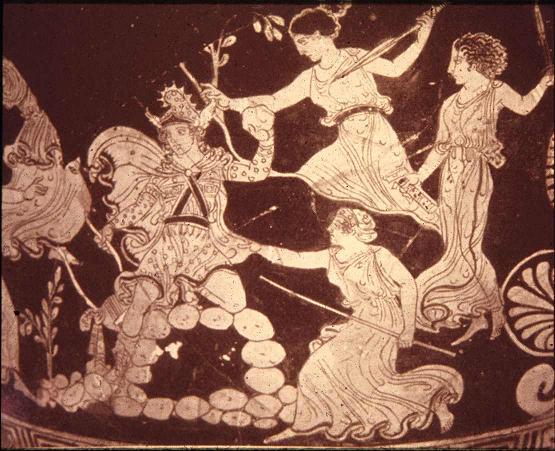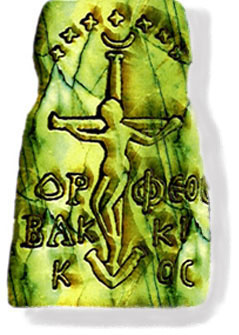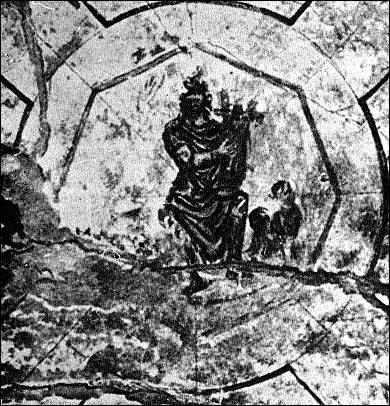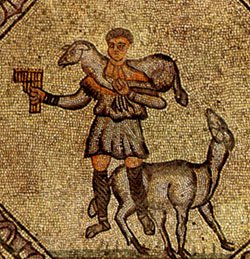|
Orpheus

Alias: (None)
Location: Asia Minor (Turkey), Greece
Cities: Thebes
Estimated Date: 500s B.C. - 400s A.D.
He is associated with Adonis, Dionysus, and Apollo
Orpheus was said to have been a supernaturally good poet and lyre-player. Orphic literature shows his followers worshipped Dionysus as Zagreus, the son and rightful heir of Zeus and Persephone, but the first century A.D. work Catasterismi by Pseudo-Eratosthenes says Orpheus did not honor Dionysus but named Helios, who he called Apollo, the highest god, and so Orpheus was punished by Dionysus by having the ecstatic revelers of Dionysus, the Maenads, tear Orpheus apart, leading to the suggestion that Orpheus may have tried to reform Dionysian worship against the will of other Dionysians. This is confirmed by first century B.C. historian, Diodorus of Sicily, who wrote “Orpheus also made many changes in the practices and for that reason the rites which had been established by Dionysus were also called ‘Orphic’.” Orpheus is also said to have authored Orphic hymns which refer to the death of resurrection as well as the ritual mourning for Adonis. Zagreus was the "first-born Dionysus" in the Orphic Mysteries. During the first century A.D., the Greek historian Strabo connected Dionysus with Sabazios (Saba-Zeus), the name of the Phrygian and Thracian mounted sky god from which the Sabazian mysteries are derived from (which, according to Aristophanes, included the weeping for Adonis).
At stated periods doom'd to set and rise, with splendid lamp, the glory of the skies. Two-horn'd and lovely, reverenc'd with tears, of beauteous form, adorn'd with copious hairs.
He is the “Good Shepherd”, a fisherman, and associated with wheat and grapes (bread and wine)
Like Jesus, Orpheus is referred to as the “Good Shepherd”. On a sacramental bowl dated to the 200s or 300s, Orpheus is portrayed with a shepherd’s staff and a fisherman’s net, just as Jesus is the shepherd and his disciples are fishermen. He stands alongside wheat and grapes, signifying a ceremony of bread and wine. The bowl is cited in Joseph Campbell's Creative Mythology.

Bowl dated to 200s or 300s A.D., depicting Orpheus with shepherd's staff and fisherman's net,
surrounded by wheat and grapes representing bread and wine
His creation story makes a reference to apples of immortality from a tree guarded by a serpent in an Eden-like garden named after Venus
Clement of Alexandria quotes the “Thracian Orpheus” on the golden apples of the Garden of Hesperides as being one of the items the Titans used to lure baby Dionysus away and then tear him apart and eat him, leaving only his heart. Zeus punishes the Titans by destroying them, and from the ashes humans are born with both the good of Dionysus and the evil of the Titans, after which Athena takes the heart so that Dionysus can be reborn. The golden apples, like the fruit of the Tree of Life, bestowed immortality. The name Hesperides is equivalent to vesper and comes from Hesperus, the evening star of Venus equivalent to Shalim, the god Jerusalem is named after and brother of Eosphorus, known in Canaan as Shahar, whose son Helel is translated in Latin as Lucifer. The Greek goddess Hera was said to have set an ever-vigalent multi-headed dragon named Ladon to guard the golden apples, although he was defeated by Hearcles, just as the Canaanite storm god Ba'al Hadad slew the multi-headed sea dragon Lotan, the storm god Zeus slew the serpent-giant Typhon, and Yahweh slew the multi-headed dragon Leviathan, who was later reimagined as the red dragon, the devil, in the Book of Revelation. According to the Argonautica from the 200s B.C., Jason and the Argonauts, including Orpheus, sailed past the Garden of Hesperides the day after the battle and saw the still-twitching dragon.
The mysteries of Dionysus are wholly inhuman; for while still a child, and the Curetes danced around [his cradle] clashing their weapons, and the Titans having come upon them by stealth, and having beguiled him with childish toys, these very Titans tore him limb from limb when but a child, as the bard of this mystery, the Thracian Orpheus, says:- “Cone, and spinning-top, and limb-moving rattles, And fair golden apples from the clear-toned Hesperides.”
And the useless symbols of this mystic rite it will not be useless to exhibit for condemnation. These are dice, ball, hoop, apples, top, looking-glass, tuft of wool.
Athene (Minerva), to resume our account, having abstracted the heart of Dionysus, was called Pallas, from the vibrating of the heart; and the Titans who had torn him limb from limb, setting a caldron on a tripod, and throwing into it the members of Dionysus, first boiled them down, and then fixing them on spits, “held them over the fire”. But Zeus having appeared, since he was a god, having speedily perceived the savour of the pieces of flesh that were being cooked,--that savour which your gods agree to have assigned to them as their perquisite, assails the Titans with his thunderbolt, and consigns the members of Dionysus to his son Apollo to be interred. And he--for he did not disobey Zeus--bore the dismembered corpse to Parnassus, and there deposited it.
He becomes a god through crucifixion
Orpheus is portrayed on a tiny (now lost) stone as crucified with a moon and seven stars above him with the inscription “Orpheus becomes a Bacchi”, insinuating that he achieved he became one with Dionysus through his death, a parallel to Christian martyr mysticism. Richard Carrier has argued the image is irrelevant because the figure is crucified on an anchor, but regardless of what the object is, the crucifixion posture itself should be more than enough evidence of a relationship. In any case, the anchor has long been known to be an ancient Christian symbol artistically linked to the cross. It has also been argued that the stone is a medieval forgery based on the iconography, but the arguments do not seem to stand up to scrutiny. There is a hostility towards the acknowledgement that the cross and crucifix are both pre-Christian symbols because unlike Judaism and Islam, Christianity has ignored the typical iconoclasm of the “monotheistic” religions and actually canonized the “graven image” of the crucifix despite the fact that it obviously violates the commandment in Exodus 20:4 against making a graven image of anything or anyone in heaven, earth or the sea. A letter attributed to the late fourth century bishop Epiphanius says that he ripped down a curtain in a Palestinian church for having an image of either Jesus or a saint – something that would today be sacrilegious – and then warned John II of Jerusalem that the church using this iconography were against their religion. Yet the typical modern, so-called “Literalist” Christian would probably consider the shepherd, fisherman and “True Son” being hung on a tree to rise again to save the worshipper to be an “idol” because it’s “pagan” or “polytheistic” and then look at the graven image of the Good Shepherd, “Fisher of Men” and true “Son of God” being “hung on a tree” (Gal. 3:13) to rise again to save the worshipper and say that is “Judeo-Christian” or “monotheistic” because Jesus, unlike Dionysus or Orpheus, is the Second Person of the Trinity. “Person” is a very purposeful term since the belief that Jesus and God are the same Person is the “modalist” heresy. It is no wonder that “idolism” has been redefined in modern times to mean abstract greed or hero-worship.

Talisman or cylinder seal reading, “Orpheus becomes a Bacchi”, dated to 200s A.D.
This is the anchor our souls have, reaching right through inside the curtain where Jesus has entered as a forerunner on our behalf, having become a high priest for ever, of the order of Melchizedek.
He descends to the netherworld and then returns
Orpheus is said to have gone down to Hades to bring back his dead wife Eurydice but failed because he broke one of Hades’ rules and looked back a split second too early after bringing her up. Eurydice’s name may have originally been a title of Orpheus’ mother, Persephone, in which case, the story could be a retelling of the older myth about Hades kidnapping Persephone and her mother Demeter going down to the underworld to find her. In that myth, which was important to the Eleusinian mysteries, the season turns to winter while Persephone’s distraught mother is looking for her, very similar to how the Dumuzi and Adonis myths in which winter occurs while Inanna and Aphrodite are distraught over their lover being gone.
His mother was impregnated by Zeus in the form of a serpent
In Orphic myths, the maiden Persephone is seduced by Zeus while he is in the form of a serpent and is impregnated with Zagreus Dionysus.
He is “born again”
Orphic literature shows his followers worshipped Dionysus as Zagreus, the son and rightful heir of Zeus and Persephone, who was slain by the Titans as a baby but “born again” when Zeus impregnated the human Semele with his heart.
He was worshipped in mystery cults that offered a happy afterlife
The second century theologian Clement of Alexanderia says Zagreus Dionysus was killed by the Titans so the twin sons of the volcano god Hephaestus deposted Zagreus’ genitals in a sacred cave on the isle of Samothraki, establishing the Samotrakian Mysteries. An Orphic Hymn indicates that mysteries of Orpheus provided hope for the afterlife.
The concave heavens with echo's voice resound, when leaves with rustling noise bestrew the ground. Kouretes, Korybantes, ruling kings, whose praise the land of Samothrake sings; great Zeus' assessors; whose immortal breath sustains the soul, and wafts her back from death; aerial-formed, who in Olympos shine the heavenly Twins [Dioskouroi, Dioscuri] all-lucid and divine; blowing, serene, from whom abundance springs, nurses of seasons, fruit-producing kings.
One of his mysteries includes crowning, robing, and piercing with a spear the remains of Dionysus, just like Jesus
In the gospels, Jesus goes through a mock ceremony of being robed in kingly purple and crowned with thorns that matches with an already well-known story from the first century Alexandrian Jew, Philo, who said that a certain youths had done this to a madman named Carabbas, a name very similar to a rebel named Barabbas or Jesus Barabbas in the Synoptic gospels. The crowd in Jerusalem is given a choice to crucify Jesus or Barabbas and they choose Barabbas, signifying the decision of Jerusalem to put their hopes in a rebellion that brought destruction to the city. The Corybantes mysteries of Orpheus appear to include a similar mock ceremony for the dead Dionysus that included the robing and crowning of his decapitaed head and his remains being pierced by a spear as in John 19:34.
The mysteries of Dionysus are wholly inhuman; for while still a child, and the Curetes danced around [his cradle] clashing their weapons, and the Titans having come upon them by stealth, and having beguiled him with childish toys, these very Titans tore him limb from limb when but a child, as the bard of this mystery, the Thracian Orpheus, says:- "Cone, and spinning-top, and limb-moving rattles, And fair golden apples from the clear-toned Hesperides."...
Athene (Minerva), to resume our account, having abstracted the heart of Dionysus, was called Pallas, from the vibrating of the heart; and the Titans who had torn him limb from limb, setting a caldron on a tripod, and throwing into it the members of Dionysus, first boiled them down, and then fixing them on spits, "held them over the fire." But Zeus having appeared, since he was a god, having speedily perceived the savour of the pieces of flesh that were being cooked,--that savour which your gods agree to have assigned to them as their perquisite, assails the Titans with his thunderbolt, and consigns the members of Dionysus to his son Apollo to be interred. And he--for he did not disobey Zeus--bore the dismembered corpse to Parnassus, and there deposited it.
If you wish to inspect the orgies of the Corybantes, then know that, having killed their third brother, they covered the head of the dead body with a purple cloth, crowned it, and carrying it on the point of a spear, buried it under the roots of Olympus. These mysteries are, in short, murders and funerals. And the priests of these rites, who are called kings of the sacred rites by those whose business it is to name them, give additional strangeness to the tragic occurrence, by forbidding parsley with the roots from being placed on the table, for they think that parsley grew from the Corybantic blood that flowed forth; just as the women, in celebrating the Thesmophoria, abstain from eating the seeds of the pomegranate which have fallen on the ground, from the idea that pomegranates sprang from the drops of the blood of Dionysus. Those Corybantes also they call Cabiric; and the ceremony itself they announce as the Cabiric mystery...
His followers tried to help others atone for their sins
Like most early Jesus sects, the “Orphic way of life” meant living an ascetic lifestyle and taking authority from sacred writings. Plato’s criticism of Orphics going door to door like Mormons proselytizing in order to help people atone for their sins, confirming that Orphic teachings were meant to provide hope for the afterlife.
And they produce a host of books written by Musaeus and Orpheus, who were children of the Moon and the Muses --that is what they say --according to which they perform their ritual, and persuade not only individuals, but whole cities, that expiations and atonements for sin may be made by sacrifices and amusements which fill a vacant hour, and are equally at the service of the living and the dead; the latter sort they call mysteries, and they redeem us from the pains of hell, but if we neglect them no one knows what awaits us.
Purgatory can be traced back to his cults
The concept of purification by fire after death was supported in second century Christianity and after by theologians such as Clement of Alexandria, Origen, Tertullian, the apocryphal author of Acts of Paul and Thecla, St. Cyprian of Carthage, Lactantius, Cyril of Jerusalem, Gregory of Nyssa, St. John Chrysostom, St. Augustine, and Pope Gregory the Great. Because our knowledge of Orhpic Purgatory is not perfect, some have suggested that the Christian concept of Purgatory should instead be traced back to Plato, but Plato was strictly against the Orphic practice of praying for the dead, which showed up not only in Christianity but also Judaism. Purgatory is described in the Discourse to the Greeks concerning Hades, which was wrongly attributed to Josephus but is found under the name Against Plato, on the Cause of the Universe in the writings of Irenaeus' student, Hippolytus of Rome. The concept of Purgatory as a specific place did not become church doctrine until the late 1100s and was then defined at the First Council of Lyon in 1245. The Eastern Orthodox Church rejects the word Purgatory but still retains a belief of purification in the afterlife while the concept is entirely rejected by Protestants.
He is displayed in a Roman tomb surrounded by Biblical scenes
In the restored ceiling of the fourth-century Domitilla Catacomb in Rome, there are eight panels circling the dome, including four panels that portray scenes from the Bible and four others showing pastoral scenes of a bull (a pagan sacrificial animal) or a ram (a Jewish sacrificial animal). The Bible scenes include: Moses drawing water from the rock, David with his sling, Daniel being cast into the lion’s den, and Jesus resurrecting Lazarus using a wand similar to the augur's wands used by the Roman priestly class. In the center of the eight panels is Orpheus playing the lyre. Catacombs in Rome, Naples and Synracuse also portray Orpheus carrying a lamb or ram across his shoulders to portray him as the “Good Shepherd”.
 
Christian catacombs show Orpheus surrounded by Biblical scenes and carrying a lamb./em>
Next God: Ba'al Hadad
The Dying-and-Rising Gods
Leave Comments Here
|

